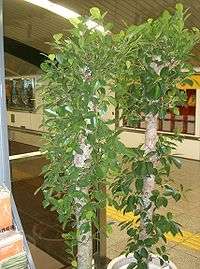Ficus microcarpa
| Ficus microcarpa | |
|---|---|
 | |
| Scientific classification | |
| Kingdom: | Plantae |
| (unranked): | Angiosperms |
| (unranked): | Eudicots |
| (unranked): | Rosids |
| Order: | Rosales |
| Family: | Moraceae |
| Genus: | Ficus |
| Species: | F. microcarpa |
| Binomial name | |
| Ficus microcarpa L.f. 1782 not Vahl 1805 | |
| Synonyms | |
|
List
| |
Ficus microcarpa, also known as Chinese Banyan, Malayan Banyan, Taiwan Banyan, Indian Laurel, Curtain fig, or Gajumaru (ガジュマル), is a banyan native in the range from Sri Lanka to India, Taiwan, the Malay Archipelago, the Ryukyu Islands, Australia, and New Caledonia.
Taxonomy


Ficus microcarpa has been described in 1782 by Carl Linnaeus the Younger. The species has a considerable number of synonyms. In 1965, E. J. H. Corner described 6 varieties and two forms of Ficus microcarpa var. microcarpa[1] which were regarded as synonyms under the name of Ficus microcarpa in the latest Flora Malesiana volume. Hill's Weeping Fig is a form of Ficus microcarpa. It was first formally described as a species in its own right (Ficus hillii) by Frederick Manson Bailey in the Botany Bulletin of the Queensland Department of Agriculture, based on the type specimen collected in the "scrubs of tropical Queensland'".[2] In 1965, it was reassigned by British botanist E.J.H. Corner as a variety of F. microcarpa, namely F. microcarpa var. hillii.
Distribution and habitat
Ficus microcarpa was widely distributed as an ornamental plant and is one of the most common street trees in warm climates. The symbiotic pollinating fig wasp, Eupristina verticillata, was introduced along with F. microcarpa. Such an introduction, however, can be delayed: in Brazil - where specimens of the tree had been used in gardening since the nineteenth century, when it was introduced by the French architect Auguste François Marie Glaziou into various public parks of Rio de Janeiro - the appearance of saplings began only during the 1970s. Such saplings are considered to be very aggressive, as they can grow in the walls of buildings, bridges, highways, and other concrete structures.[3] The tree is considered a major invasive species in Hawaii, Florida, Bermuda, Central America, and South America.
Ecology
The pollinating fig wasp associated with Ficus microcarpa is Eupristina verticillata. In addition, 19 non-pollinating fig wasp species parasitize Ficus microcarpa figs.[4]
These fig wasps are from different families. First, the Eurytomidae wasps are Sycophila curta, Sycophila petiolata, Sycophila maculafacies and Bruchophagus sensoriae. The wasps from the Pteromalidae family are the most speciose: Acophila microcarpae, Eufroggattisca okinavensis, Meselatus bicolor, Micranisa degastris, Odontofroggatia corneri, Odontogroggatia gajimaru, Odontogroggatia galili, Odontofroggatia ishii, Philotrypesis emeryi, Philotrypesis okinavensis, Philotrypesis taiwanensis, Sycoryctes moneres, Sycoscapter gajimaru, Walkerella kurandensis. Only one species from the Ormyridae family: Ormyrus lini.
In some parts of its introduced range, it is very attractive to avian wildlife: in São Paulo, Brazil, ten species of birds were listed as feeding on its fruits, especially Turdus rufiventris, Pitangus sulphuratus, Turdus leucomelas, Thraupis sayaca and Celeus flavescens.[5] Its fruit and leaves are also sought after and eaten by the parrot Aratinga leucophthalmus.[6] Although invasive, its hardiness makes it an important species for the attraction of avian wildlife in urban environments.[7]
Cultivation

Ficus microcarpa is cultivated as an ornamental tree for planting in gardens, parks, and in containers as an indoor plant and bonsai specimen.
External links
- Plants of Hawaii: Ficus microcarpa, hear.org
- Ficus microcarpa L.f., Natural Resources Conservation Service of the U.S. Department of Agriculture
- Indian Laurel Invasive Plant Page, Bermuda Department of Conservation Services.
References
- ↑ Corner, E. J. H. (1965). "Check-list of Ficus in Asia and Australasia with keys to identification". The Gardens' Bulletin Singapore. (digitised, online, via biodiversitylibrary.org) 21 (1): 1–186. Retrieved 5 Feb 2014.
- ↑ "Ficus microcarpa var. hillii (F.M.Bailey) Corner". Australian Plant Name Index (APNI), IBIS database. Centre for Plant Biodiversity Research, Australian Government.
- ↑ Carauta, Jorge Pedro Pereira & Diaz, B. Ernani, Figueiras no Brasil, Rio de Janeiro, UFRJ, 2002, ISBN 85-7108-250-2, pg.155
- ↑ Chen, Ying-Ru; Wen-Chung Chuang; Wen-Jer Wu (1999). "Chalcids wasps on Ficus microcarpa L. in Taiwan (Hymenoptera: Chalcidoidea)". Journal of Taiwan Museum 52: 39–79.
- ↑ Somenzari, Marina; Linda Lacerda da Silva; Rosanna G. Q. Benesi (2006). "Atração de aves por Ficus elastica Roxb. e Ficus microcarpa L. em ambiente urbano (abstract)" (PDF). XIV Congresso Brasileiro de Ornitologia. Cite uses deprecated parameter
|coauthors=(help) - ↑ da Silva, Linda Lacerda; Sonia Maria de Amorim Gimenez, Sumiko Namba (2006). "Método quantitativo para a avaliacão da preferência alimentar de Aratinga leucophthalmus em cativeiro (abstract)" (PDF). XIV Congresso Brasileiro de Ornitologia. Cite uses deprecated parameter
|coauthors=(help) - ↑ Frisch, Johan Dalgas & Frisch, Christian Dalgas, Aves Brasileiras e Plantas que as Atraem, São Paulo:2005, ISBN 85-85015-07-1 , pg.366
| Wikimedia Commons has media related to Ficus microcarpa. |